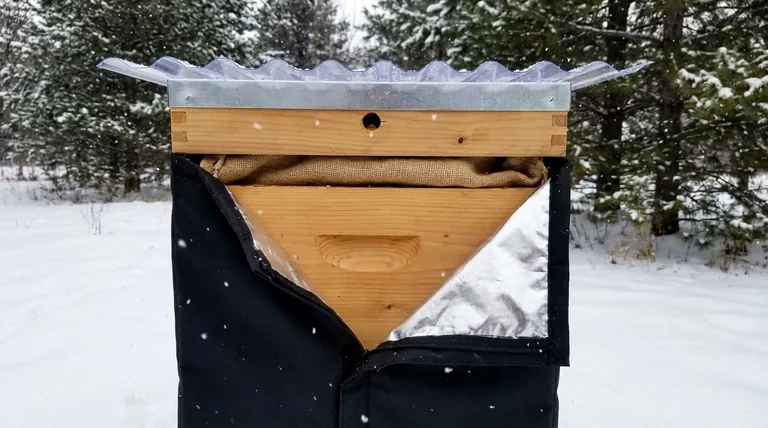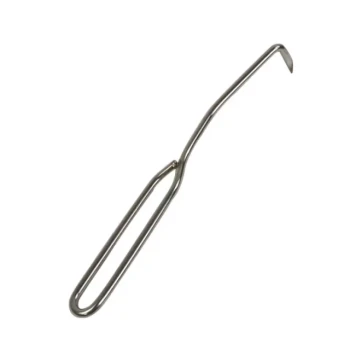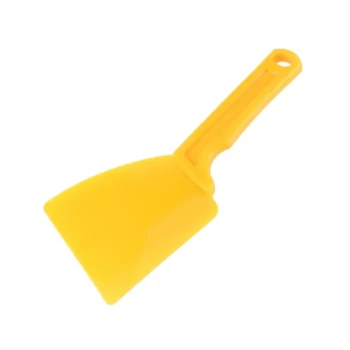The most effective ways to control moisture in a hive during winter are to use absorbent materials inside the hive to trap condensation and to ensure the hive is protected from external moisture. Materials like burlap can wick moisture away from the bee cluster, while external coverings like polycarbonate sheeting can prevent rain and snow from entering the hive in the first place.
The core challenge of winter hive management is not the cold itself, but the moisture created by the bees' own respiration. Your goal is to manage this inevitable water vapor, preventing it from condensing and dripping back onto the cluster as cold water.

The Source of Winter Moisture
To effectively manage moisture, you must first understand its origin. The problem isn't rain or snow leaking in (though that must be prevented); it's the bees themselves.
The Cluster as a Living Furnace
Bees form a tight cluster in winter, vibrating their wing muscles to generate heat. This metabolic process, fueled by their honey stores, releases a significant amount of warm, moist air, just like our own breath on a cold day.
The Physics of Condensation
This warm, vapor-laden air rises from the cluster. When it hits a cold surface, typically the underside of the inner cover or hive lid, it rapidly cools and condenses into liquid water. This cold water then drips down, and if it lands on the cluster, it will chill and kill the bees.
Key Strategies for Moisture Control
A successful wintering strategy often involves a combination of methods. You are creating a system that allows the hive to breathe without creating deadly drafts or drips.
1. The Absorption Method
This strategy involves placing an absorbent material above the bee cluster to trap condensation before it can drip.
Using Absorbent Materials
Materials like burlap, straw, or wood shavings are excellent for this purpose. They are placed in a spacer rim or an empty hive box (often called a "quilt box") directly above the top bars of the uppermost box containing bees.
How It Works
These materials act like a sponge, wicking moisture out of the air. This keeps the air drier and prevents water from pooling and dripping. The material needs to be checked periodically and replaced if it becomes saturated.
2. The Ventilation Method
This strategy focuses on allowing the warm, moist air to escape the hive before it has a chance to condense.
Creating an Upper Entrance
Providing a small upper entrance—a 1/2-inch hole drilled in the top box or a shim that cracks the lid slightly—creates a "chimney effect." The warm, moist air can vent out, preventing a buildup of humidity.
The Role of Insulation
Combining ventilation with top insulation (like a foam board placed above the inner cover) is highly effective. The insulation keeps the top surface of the hive warmer, raising the point of condensation above the absorbent material or pushing the moist air out the vent.
3. The External Protection Method
This strategy ensures that no moisture is entering the hive from the outside environment.
Sealing the Envelope
Even a well-ventilated hive will fail if it's sitting in a puddle or exposed to driving rain. Ensure the hive is tilted slightly forward so any water on the bottom board drains out the entrance.
Using External Covers
For hives with older lids or potential leaks, polycarbonate corrugated sheeting or even simple tar paper wrapped around the hive can provide an essential barrier. This ensures that the only moisture you have to manage is the moisture created by the bees.
Understanding the Trade-offs
There is no single "perfect" solution; each approach has considerations. The key is to find the right balance for your specific climate and equipment.
Ventilation vs. Heat Loss
The primary trade-off is between ventilation and heat retention. Too much ventilation can create a draft, forcing the bees to consume more honey to stay warm. Too little ventilation traps moisture, creating a damp, cold environment that is far more dangerous than dry cold.
The Risk of Saturated Materials
If you rely solely on the absorption method, the absorbent material can become saturated with water. If a hard freeze occurs, you will have a large block of ice directly above your bee cluster, which defeats the purpose entirely. This is why combining absorption with ventilation is often the best approach.
Making the Right Choice for Your Hive
Your local climate and beekeeping philosophy will guide your decision. Most successful beekeepers use a combination of the strategies above.
- If your primary focus is simplicity: Using a quilt box with wood shavings or burlap above the cluster is a simple and effective absorption method.
- If you are in a damp, mild climate: Prioritizing an upper entrance for ventilation is critical to constantly exhaust humid air.
- If you are in a very cold, windy climate: Combining top insulation with a small, vented quilt box provides the best balance of heat retention and moisture control.
- If your equipment is old or imperfect: Wrapping the hive or using a protective cover like polycarbonate sheeting is a non-negotiable first step to keep external water out.
Ultimately, your role is to create a dry, draft-free cavity that allows your bees to manage their own temperature effectively through the winter.
Summary Table:
| Method | Purpose | Key Materials/Techniques |
|---|---|---|
| Absorption | Trap condensation before it drips | Burlap, wood shavings, quilt box |
| Ventilation | Allow moist air to escape | Upper entrance, top insulation |
| External Protection | Keep rain and snow out | Polycarbonate sheeting, hive wrapping |
Protect Your Apiary Investment This Winter
Winter hive failure is often caused by moisture, not cold. Ensure your bees survive and thrive with the right equipment. HONESTBEE supplies durable, winter-tested beekeeping supplies and equipment to commercial apiaries and distributors through our wholesale-focused operations.
From moisture-wicking materials to protective covers, we provide the reliable tools you need for successful overwintering. Let's discuss your specific needs and scale.
Contact HONESTBEE today for wholesale pricing and expert support.
Visual Guide

Related Products
- Professional Insulated Winter Hive Wrap for Beekeeping
- HONESTBEE Professional Long Handled Hive Tool with Precision Cutting Blade
- Wholesales Dadant Size Wooden Bee Hives for Beekeeping
- Honey Flow Garden Bee Hive Flow Hive Best Beehive for Beginners
- Telescopic Beehive Outer Cover Lid Roof with Galvanised Sheeting for Langstroth Hive and Beehive Outer Cover
People Also Ask
- Should bee hives be insulated? Protect Your Colony from Moisture, Not Just Cold
- What are the steps to properly wrap a beehive for winter? Ensure Your Colony Survives the Cold
- Why is insulation important for hives during winter? Ensure Your Bees Survive and Thrive
- Is it always necessary to insulate beehives? A Guide to Winter Survival & Colony Health
- What are the benefits of insulated beehives in cold weather? Boost Winter Survival & Spring Productivity



















